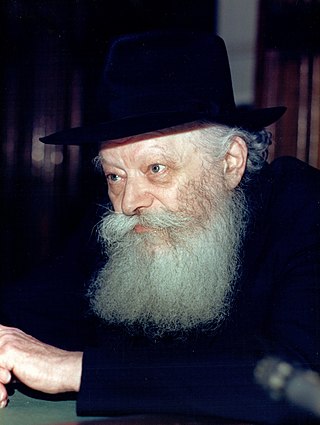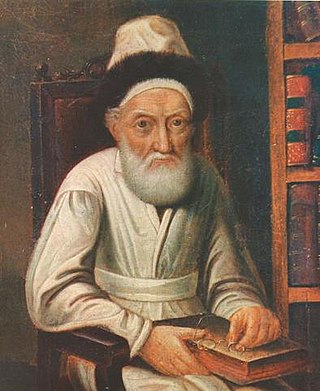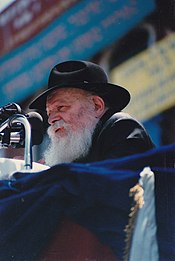
Menachem Mendel Schneerson, known to adherents of the Chabad-Lubavitch movement as the Lubavitcher Rebbe or simply the Rebbe, was a Russian-American Orthodox rabbi and the most recent Rebbe of the Lubavitch Hasidic dynasty. He is considered one of the most influential Jewish leaders of the 20th century.

Chabad, also known as Lubavitch, Habad and Chabad-Lubavitch, is a dynasty in Hasidic Judaism. Belonging to the Haredi (ultra-Orthodox) branch of Orthodox Judaism, it is one of the world's best-known Hasidic movements, as well as one of the largest Jewish religious organizations. Unlike most Haredi groups, which are self-segregating, Chabad mainly operates in the wider world and caters to nonobservant Jews.

Menachem Mendel Schneersohn also known as the Tzemach Tzedek was an Orthodox rabbi, leading 19th-century posek, and the third rebbe of the Chabad Lubavitch Hasidic movement.

Yosef YitzchakSchneersohn was an Orthodox rabbi and the sixth Rebbe of the Chabad Lubavitch Hasidic movement. He is also known as the Frierdiker Rebbe, the Rebbe RaYYaTz, or the Rebbe Rayatz. After many years of fighting to keep Orthodox Judaism alive from within the Soviet Union, he was forced to leave; he continued to conduct the struggle from Latvia, and then Poland, and eventually the United States, where he spent the last ten years of his life.

Schneersohn is a Jewish surname used by many of the descendants of Rabbi Shneur Zalman of Liadi, the first Rebbe of the Chabad-Lubavitch Hasidic movement.

Kehot Publication Society is the publishing division of the Chabad-Lubavitch movement.

Levi Yitzchak Schneerson was a Chabad-Lubavitch Hasidic rabbi in Yekaterinoslav, Russian Empire. He was the father of the seventh Chabad-Lubavitch Rebbe, Rabbi Menachem Mendel Schneerson.

Hayom Yom is an anthology of Hasidic aphorisms and customs arranged according to the calendar for the Hebrew year of 5703 (1942–43). The work was compiled and arranged by Rabbi Menachem Mendel Schneerson, the seventh Rebbe of Chabad, from the talks and letters of the sixth Chabad Rebbe, Rabbi Yosef Yitzchok Schneersohn. The work was published in 1943.

The Kopust branch of the Chabad dynasty of Hasidic Judaism was founded in 1866 by Yehuda Leib Schneersohn after the death of his father Menachem Mendel Schneersohn, the third Chabad rebbe. It is named after the town of Kopys in the Vitebsk Region of present-day Belarus, where Yehuda Leib Schneersohn settled after his father's death.
Barry Gurary was a rabbi. He was the nephew of Rabbi Menachem Mendel Schneerson, the seventh Lubavitcher rebbe.

The Library Of Agudas Chassidei Chabad is a research library owned by Agudas Chasidei Chabad whose content was collected by the rebbes of Chabad-Lubavitch. The library is housed next to the Lubavitch world headquarters at 770 Eastern Parkway in Brooklyn, New York, and is utilized by Chabad and general Judaic scholars. It is viewed by thousands of visitors each year.

Messianism in Chabad refers to the belief within the Chabad-Lubavitch community—a prominent group within Hasidic Judaism—regarding the Jewish messiah. Central to this belief is the conviction that Rabbi Menachem Mendel Schneerson, the seventh Rebbe of the Chabad-Lubavitch dynasty, is the awaited Messiah who is leading the Jewish people into the Messianic era.

The Ohel is an ohel in Cambria Heights, Queens, New York City, where Rabbi Menachem Mendel Schneerson and his father-in-law Rabbi Yosef Yitzchok Schneersohn, the two most recent rebbes of the Chabad-Lubavitch dynasty, are buried. Both Jews and non-Jews visit The Ohel for prayer, and approximately 50,000 people make an annual pilgrimage there on the anniversary of Schneerson's death.

11 Nissan or Yud Aleph Nissan is a holiday on the Chabad-Lubavitch calendar that marks the birthday of the Lubavitcher Rebbe, Rabbi Menachem Mendel Schneerson. Rabbi Schneerson was born on April 5, 1902 corresponding to 11 Nissan 5662.

Chabad offshoot groups are those spawned from the Chabad Hasidic Jewish movement. Many of these groups were founded to succeed previous Chabad leaders, acting as rivals to some of the dynastic rebbes of Chabad. Others were founded by former students of the movement, who, in forming their own groups, drew upon their experiences at Chabad.

Chabad customs and holidays are the practices, rituals and holidays performed and celebrated by adherents of the Chabad-Lubavitch Hasidic movement. The customs, or minhagim and prayer services are based on Lurianic kabbalah. The holidays are celebrations of events in Chabad history. General Chabad customs, called minhagim, distinguish the movement from other Hasidic groups.
Nissan Mindel was a Chabad Hasidic rabbi, author, editor, and served on the administrative staff of Rabbi Menachem Mendel Schneerson, the seventh Lubavitcher Rebbe.
Shaina Horenstein was the youngest daughter of Rabbi Yosef Yitzchak Schneersohn, the sixth Rebbe of the Chabad Hasidic movement. In the Chabad community, she is referred to as Rebbitzin Shaina.

Yisroel Jacobson (1895-1975) was a Chabad Hasidic rabbi and the representative of the sixth Chabad rebbe, Yosef Yitzchak Schneersohn, to the United States during the 1920s and 1930s. He was one of the first Lubavitcher activists to arrive in to the United States. He was born in Russia and migrated to the United States in 1925.

12–13 Tammuz or Yud beis v' yud gimel Tammuz is a holiday on the Chabad-Lubavitch calendar that commemorates the liberation of Rabbi Yosef Yitzchak Schneerson, the sixth Rebbe of the Chabad-Lubavitch dynasty, from Soviet imprisonment. The holiday also marks his birthday. It is one of the three holidays named "day of liberation" by Chabad-Lubavitch













